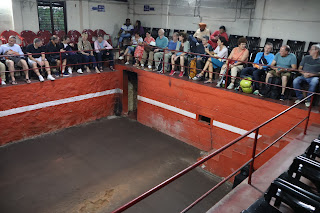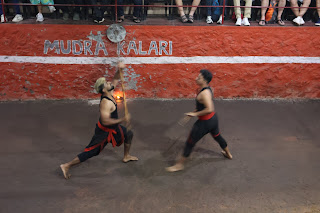The Mudra Cultural Centre in Thekkady shows you good Kalari performances. Since there is audience interaction, you get involved in the show.
Kalaripayattu (also known simply as Kalari) is an Indian martial art that originated in Kerala, a state on the southwestern coast of India during the 11th–12th century CE.
According to legend, Parashurama, the sixth avatar of Vishnu, learned the art from Shiva, and taught it to the original settlers of Kerala shortly after bringing Kerala up from the ocean floor.
According to Philip Zarrilli, the Tamil combat techniques of the Sangam period (600 BCE–300 CE) and Sanskritic Dhanur Vedic traditions, which arrived with northern Brahmins from the 7th CE onwards, were the earliest precursors to Kalaripayattu.
|
The Mudra Cultural Centre is located in Thekkady |
|
Specialized training ground known as a kalari
|
|
Weaponry and armor
|
|
Chuvadu and Vadivu
|
|
Creating circles with fireballs |
|
Jumping through rings of fire |
|
Forming circles of fire with sparks |
|
At the end the artists thank the audience for their applause |
See Also
-
Pepper County Periyar, Attappallam
-
Our Lady of Good Health Church, Peermade
-
Kerala Backwaters Cruise, Alappuzha
Source
Location











































